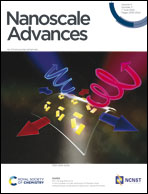Impact of secondary salts, temperature, and pH on the colloidal stability of graphene oxide in water†
Abstract
The stability of graphene oxide (GO) in water is extremely relevant because of its application as an adsorbent material, as well as for its fate and behavior in the environment. Zeta potential was used to study the effect of secondary salts (carbonate, sulfate, and phosphate), temperature (20 to 60 °C), and pH (5 to 9) on the stability of six different GOs produced from natural, synthetic, and amorphous graphite—with and without the use of attrition milling. Generally, GOs produced with attrition-milled graphites had lower ζ-potentials than their unmilled counterparts because of their smaller particle sizes and higher concentration of oxygen-containing functional groups. It was observed that GO produced from graphite and synthetic graphite had ζ-potential values lower than −30 mV, even at 30 °C. However, it was observed that all the GOs studied were unstable in the presence of carbonate and sulfate salts at concentrations between 170 and 1695 mg L−1, as they reached a ζ-potential of −4.1 mV. Density-functional theory electronic structure calculations suggested that the instability of GO in the presence of carbonate and sulfate was caused by the abstraction of a proton resulting in interaction energies Eint of 28.3 and 168.9 kJ mol−1, respectively. Our results suggest that temperatures above 30 °C, as well as carbonate and sulfate salts at concentrations relevant to arid and semi-arid regions, could promote the formation of agglomerates of GO, thus limiting its use and mobility in water.



 Please wait while we load your content...
Please wait while we load your content...